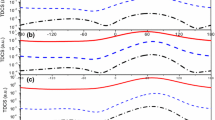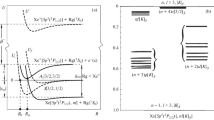Abstract
The electron-ion capture rate for low electron energies is calculated for various electron velocity distributions. Capture rates for electron-ion recombination stimulated by irradiation with light are evaluated. The results are applied to electron cooling and to positron-antiproton recombination to form antihydrogen. It is shown that laser-induced capture is a powerful method to study the electron cooling process and to maximize the antihydrogen rate. With this technique a pulsed antihydrogen beam of selectable energy and well collimated with an intensity of a few atoms per second can be anticipated.
Similar content being viewed by others
References
Lefèvre, P., Möhl, D., Plass, G.: 11th Int. Conf. on High-Energy Accelerators, Geneva, 1980, p. 819. Basel: Birkhäuser Verlag 1980
Hütten, L., Poth, H., Wolf, A., Haseroth, H., Hill, Ch.: The electron cooling device for LEAR. Gastaldi, U. (ed.). Proc. Workshop on Physics at LEAR with Low-Energy Cooled Antiprotons, Erice, May 1982 (to be published)
Budker, G.I., Skrinsky, A.N.: Sov. Phys.-Usp.21, 277 (1978)
Bell, M., Chaney, J., Herr, H., Krienen, F., Møller-Petersen, P., Petrucci, G.: Nucl. Instrum. Methods190, 237 (1981)
Herr, H., Möhl, D., Winnacker, A.: Production of and Experimentation with Antihydrogen at LEAR. Gastaldi, U. (ed.). Proc. Workshop on Physics at LEAR with Low-Energy Cooled Antiprotons, Erice, May 1982 (to be published)
Derbenev, Ya.S., Skrinsky, A.N.: Part. Accel.8, 235 (1978)
Stobbe, M.: Ann. Phys.7, 661 (1930)
Bethe, H., Salpeter, E.: Quantum mechanics of one- and two-electron systems. In: Handbuch der Physik. Vol. 35, p. 88. Berlin, Heidelberg, New York:Springer 1957
Baratella, P., Puddu, G., Quarati, F.: Z. Phys. A — Atoms and Nuclei300, 263 (1981)
Spitzer, L.: Physics of fully ionized gases. New York: Interscience 1956
Bell, M., Bell, J.: Part. Accel.12, 49 (1982) and references therein
Budker, G.I., Dikansky, N.S., Kudelainen, V.I., Meshkov, I.N., Parchomchuk, V.V., Pestrikov, D.V., Skrinsky, A.N., Sukhina, B.N.: Part. Accel.7, 197 (1976)
Studies on electron cooling of heavy particle beams, CERN 77-08 (1977)
Parchomchuk, V.V.: Private communication
Junker, B.R., Bardsley, J.N.: Phys. Rev. Lett.28, 1227 (1972)
Kolos, W., Morgan, D.L., Schrader, D.M., Wolhiewicz, L.: Phys. Rev. A11, 1792 (1975)
Câmpaneu, R.I., Beu, T.: Phys. Lett.93 A, 223 (1983)
Mills, A.P.: Appl. Phys.23, 189 (1980)
Author information
Authors and Affiliations
Rights and permissions
About this article
Cite this article
Neumann, R., Poth, H., Winnacker, A. et al. Laser-enhanced electron-ion capture and antihydrogen formation. Z Physik A 313, 253–262 (1983). https://doi.org/10.1007/BF01439477
Received:
Issue Date:
DOI: https://doi.org/10.1007/BF01439477




